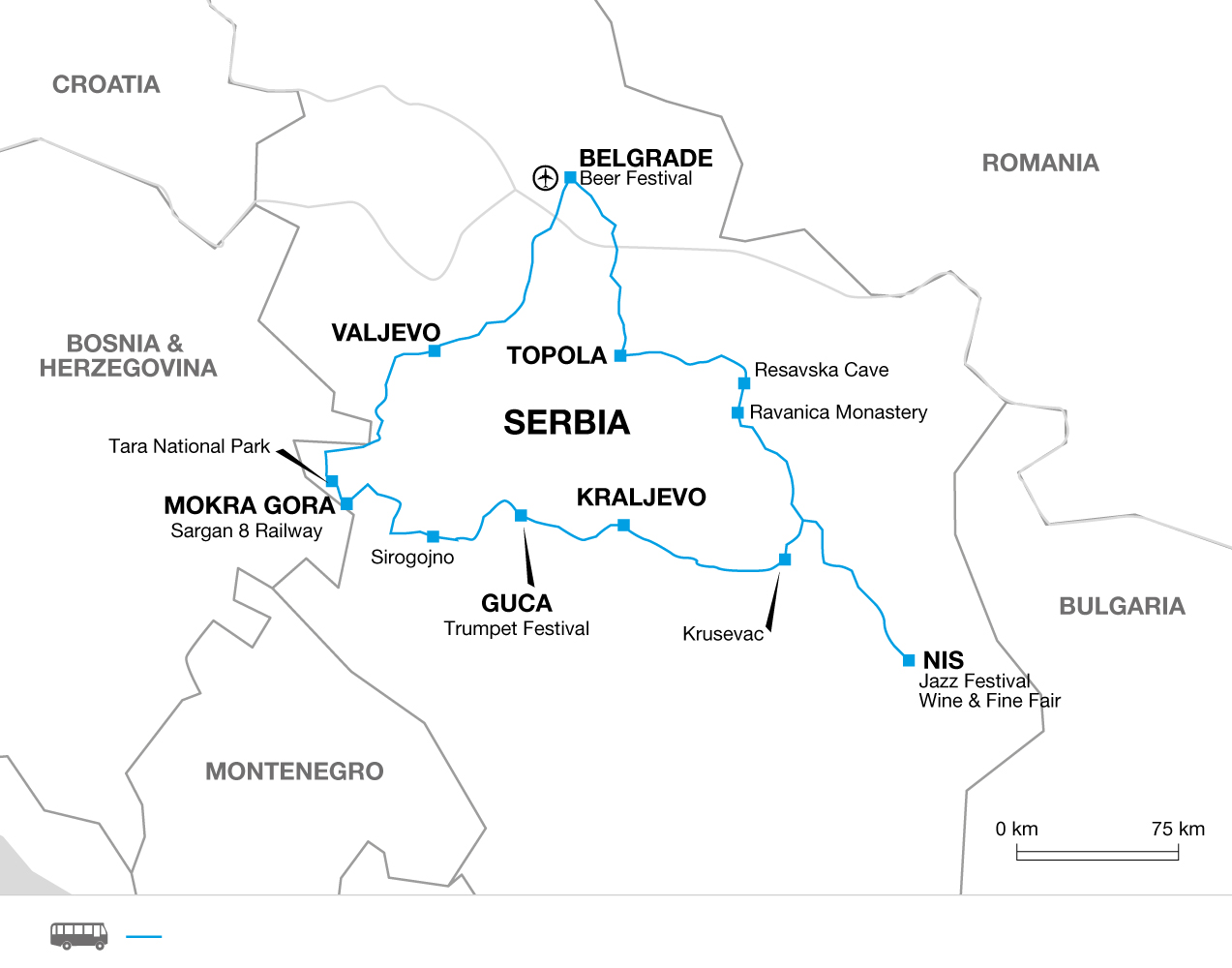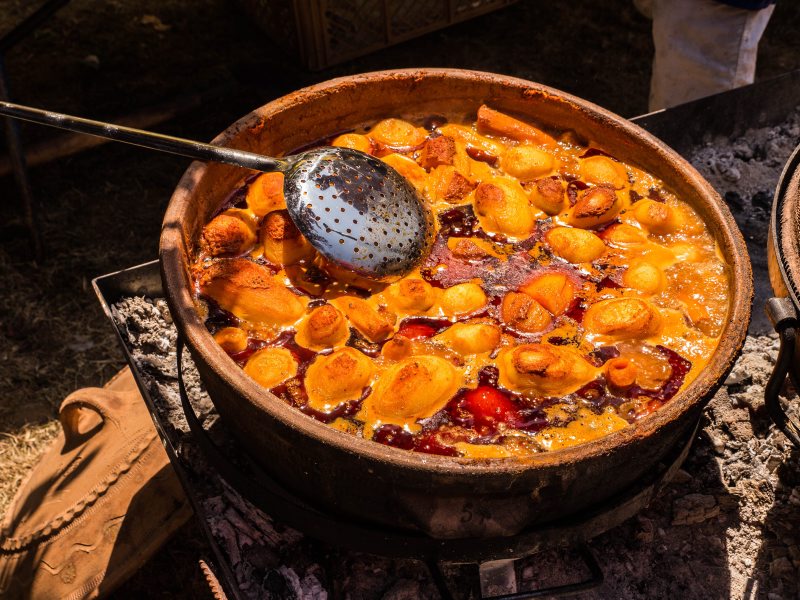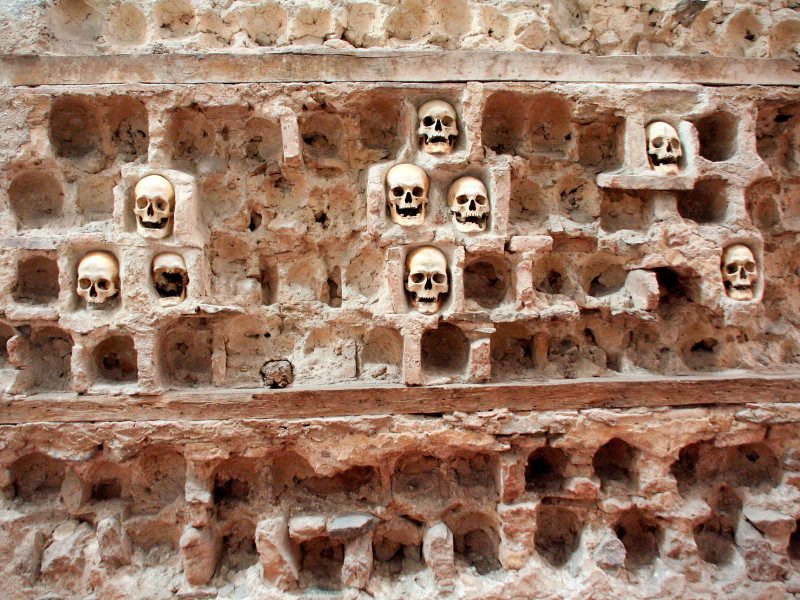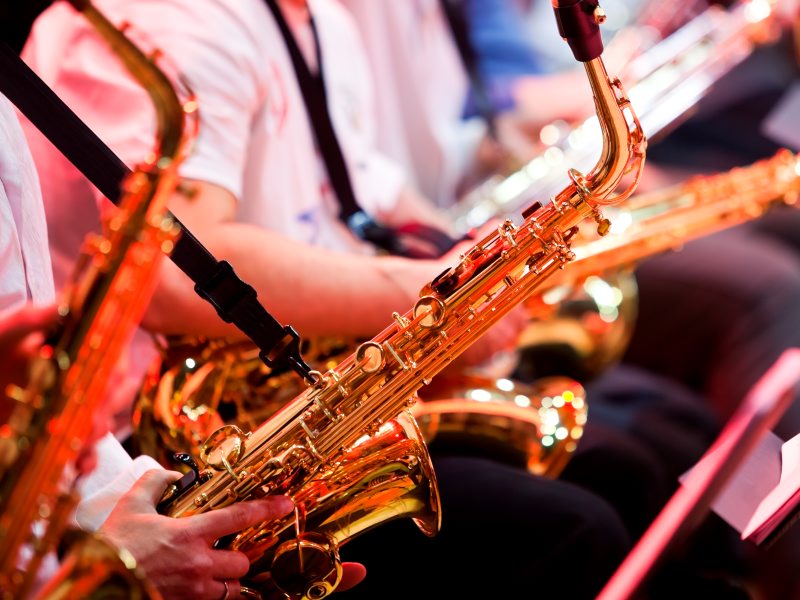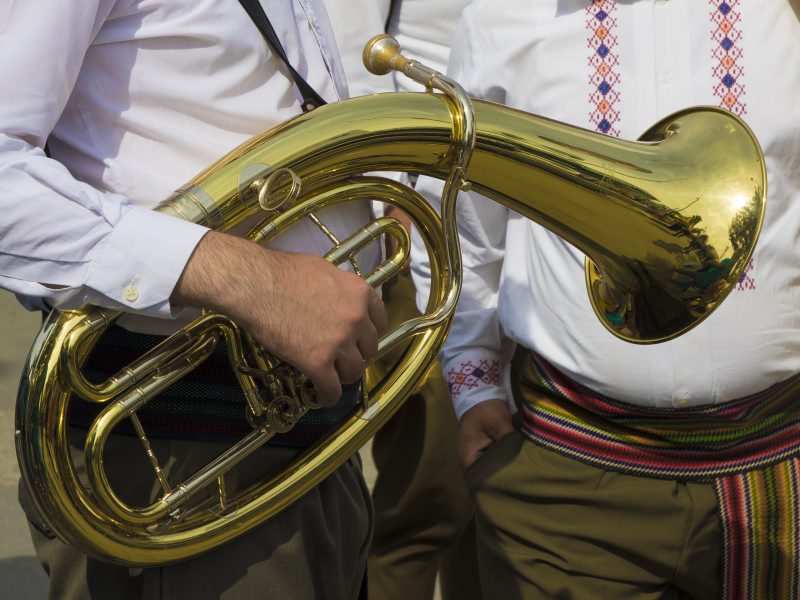Serbian Summer Festivals
Serbian Summer Festivals
This tour is no longer available, here are some similar tours:
Serbian Summer Festivals
Visiting: Serbia
Tour operator:
Tour code:
SEF
Guide Type:
Fully Guided
Age range:
14+
Trip Styles:
Tour Overview
On this trip discover not just one, but three unique festivals as well as experiencing the highlights of Serbia including its wildest and most attractive national park, Tara, and riding on the historic Sargan Eight railway.
Guca Trumpet Festival - Listen to brass band music, drink homemade plum brandy and tuck in to barbecued meats and goulash at this energetic festival
Nisville International Jazz Festival - Visit one of the largest jazz festivals in Europe to listen to traditional and contemporary music in Nis's citadel
Belgrade Beer Festival - See Serbia's capital city come alive at this annual celebration of both domestic and international beers accompanied by a variety of live music
Highlights
- Guca Trumpet Festival - At this energetic festival you can listen to brass band music, drink homemade plum brandy and tuck in to delicious barbecued meats and goulash
- Nisville International Jazz Festival - Visit one of the largest jazz festivals in Europe where you can listen to both traditional and contemporary music in Nis's citadel
- Nis Wine and Fine Fair - Chance to sample wine from around 30 different Serbian vineyards along with locally produced brandy, olive oil and cheese
- Belgrade Beer Festival - See Serbia's capital city come alive at this annual celebration of both domestic and international beers accompanied by a variety of live music
- Tara National Park - As well experiencing Serbian culture and music we will discover its wildest and most attractive national park
Itinerary
Day 1: Join trip in Belgrade
Our trip begins in the capital, Belgrade. This romantic city lies on the confluence of the Sava and the Danube Rivers and it's said that Belgrade, meaning 'the white city', is where the rivers met and fell in love. However, it's certainly not always been a peaceful picture, but bustling with locals and visitors it's now rising from its turbulent past and is quickly becoming one of the 'must see' places in the Balkans. You'll find a selection of great restaurants and bars to choose from this evening. Paprika is arguably the most popular ingredient in Serbian cooking and they tend to use the red fruit itself rather than the dried spice. You'll find it chopped up in salads with tomatoes, cucumber and cheese, chargrilled with barbequed meats, pickled, stuffed and even mashed. They also love cream and kajmak, a partially fermented thick cream, which is often served with grilled meats or fresh bread. It's a bit like a cross between sour cream and clotted cream. Rakia is the most popular spirit and it's normally distilled from plums or grapes, but you can also find more unusual variations like quince, walnut or honey.
Day 2: Explore Belgrade on foot; visit Nenadovic Tower in Valjevo
Today will begin with a guided walking tour of the capital to discover the fascinating history including that of the Roman and Ottoman empires through to the more recent conflicts of the early nineties. The city's highlights include Belgrade Fortress and the surrounding Kalmegdan Park, overlooking the rivers. Built by the Celts, the fortress has been strategically used by the Ottomans and Romans, burnt down by the Goths and Huns and rebuilt since. This afternoon we drive to the historic town of Valjevo in western Serbia, which sits on the banks of four rivers and has two old quarters. On one side of the city lies the old centre of Tesnjar, with its Ottoman architecture of small houses and cobbled streets, it's often used as a film shooting location. Whereas the other old quarter feels far more Western European. This afternoon we'll visit the square stone Nenadovic Tower, which was used by rebel fighters during the First Serbian Uprising. We'll also see the National Museum, which has more than 50,000 items on display and includes the Muslim's Lodgings which date from the 18th century and is the oldest building in the town.
Day 3: Walk in Tara National Park and take a train journey in the mountains
This morning we make our way into Tara National Park. According to mythology, Tara Mountain gets its name from the ancient, Slavic God Tar who chose this area as his home due to the outstanding natural beauty. We will take a one hour walk along the gravel path to Banjska Stena which is arguably the best view in Serbia. From this vantage point we'll be able to look out over the Drina Canyon and see the mountains in the distance, which really captures the stunning scenery of Serbia. We then drive to Mokra Gora where we board the famous Sargan Eight narrow-gauge railway, which once ran daily between Sarajevo and Belgrade and this section was reopened to tourism in 1999. It was once admired the world over as a piece of world-class engineering, for it allows the train to make the steep climb through the mountains on rails that form a figure of eight as they weave through 22 tunnels and cover just over 15 kilometres. As the crow flies, the distance between the stations of Mokra Gora and Sargan is a mere 3.5 kilometres. The train route once brought prosperity to a cut-off region of West Serbia but now offers nostalgic rides up the mountain. The train will make multiple stops along the way for the chance to overlook the wilderness of Tara National Park and there's time for an ice cream or a strong Serbian coffee at the top. After our train ride we drive to Kustendorf where we will stay the night. This distinctive mountain village was built by the international film director, Emir Kusturica, for his movie 'Life is a Miracle'. Everything here is constructed from wood and he wanted to recreate a traditional Serbian village, with the exception that all the streets are named after famous film directors. Now days, it is his home, a hotel and also home to an annual international film and music festival. As well as the chance to enjoy the fantastic mountain scenery, here there is also a small art gallery exhibiting local Serbian artists.
Day 4: Visit Sirogojno Open Air Museum; attend the Guca Trumpet Festival
Our day begins by driving to the highland village of Sirogojno. Once famed for its high-quality knitwear during the 1970s, Sirogojno sweaters graced the catwalks from Paris to Rome. Today, its home to an intriguing open-air museum where visitors can learn about traditional Serbian lifestyles and craftsmanship. Covering nearly 15 hectares, it contains a collection of 19th century wooden buildings that have been assembled here from across the region, including a bakery, an inn and a dairy. We drive to the village of Zlakusa and make a brief visit to the Ethnographic Park of Terzica Avlija with its colourful country houses dating between 1907-1925 and see its picturesque flower filled gardens. After time for lunch where you can choose to taste homemade juices and traditional Serbian cuisine such as cabbage rolls or the meat and vegetable stew of muckalica. We arrive in Guca village later this afternoon where we attend the Guca Trumpet Festival - the largest brass band event in the world! This celebration is like a cross between Glastonbury, FA Cup final day and the Olympics, as trumpeters compete for the honour of winning the Golden Trumpet. This normally sleepy village with around 2,000 residences sees in excess of 600,000 people come to listen to brass band music, drink homemade plum brandy and tuck in to delicious barbecued meats and goulash. The inaugural event took place in 1661 in a small churchyard where just four local orchestras competed but by the 1970s it had gained international recognition and has continued to grow ever since. After spending the afternoon at the celebrations to enjoy the energetic atmosphere and stirring music we drive to Kraljevo and check-in to our hotel for the night.
Day 5: See a medieval fortress and churches; attend Nisville Jazz Festival
We start off today by visiting the Serbian Orthodox monastery of Ljubostinja, which is set in a small mountain river valley. The monastery was built in the 14th century on the spot where Prince Lazar met Princess Milica for the first time and the name Ljubostinja means 'place of love'. Sadly Lazar was killed in the Battle of Kosovo and his beloved wife then as an act of mourning choose to become a nun. We drive on to the city of Krusevac where we'll have the opportunity to get lunch. After this we'll visit the ruined medieval fortress of Lazarev Grad, which was built to protect the former capital of Prince Lazar. We also discover the Lazarica Church, which is a wonderful preserved example of Serbian architecture from the same period and is the last fully intact part of what would have been a vast fortress complex. This afternoon we arrive in Nis. This cosmopolitan city is a place where old meets new, where you can see new cars travelling beside horse and carts. It's a university city, so its old alleyways are home to sophisticated cocktail bars, as well as pop-up markets in summer and it has a burgeoning music scene, which we'll get to experience at the Nisville International Jazz Festival. It's one of the largest jazz festivals in Europe and here we can listen to both traditional and contemporary music in Nis's historic citadel. Different events start in the early afternoon so you can choose which stage to visit depending on your own personal tastes and there also a number of exhibits to see. We'll collect our wristbands on arrival, so you'll be free to come and go as you please and our hotel is just a very short walk from the festival site. The festivities will go on to the small hours of the morning, but you of course could decide to head for bed earlier than this if you wish to. Whilst wandering between the music stages in the centre of Nis you can also visit the Nis Wine and Fine Fair where you have the chance to sample and purchase wine from around 30 different Serbian vineyards along with locally produced brandy, olive oil and cheese.
Day 6: Lunch in a village wine cellar; attend Nisville Jazz Festival
This morning we'll explore Nis' surroundings and visit the red bricked Latin Church and Cegar Hill where the battle of Cegar took place between the Serbian Revolutionaries and Ottoman army, as part of the First Serbian Uprising in 1809. We drive on to Malca village where we'll have lunch in a small local wine cellar. We'll get to sample local specialities and of course a variety of their red and white wines. After lunch we'll return to Nis to once again visit the jazz festival. Each day there will be a range of different performers to see and like yesterday you'll still have your wristband on and be able to come and go as you please and see whatever acts take your fancy.
Day 7: Free day in Nis; chance to visit the infamous Skull Tower
After two evenings spent attending the music festival we take a break today, so that you can relax and catch up on sleep in if you want to. Alternatively you might like to take the opportunity to discover more of Nis. You may want to take a stroll through the historic Bubanj Memorial Park, which was built to commemorate the execution of over 10,000 of the city's residents during World War II. Or maybe you could visit the iconic Skull Tower which is embedded with the skulls of the rebels that fought and lost to the Ottoman forces at the Battle of Cegar. Perhaps choose to go to the Red Cross Nazi Concentration Camp where you can learn the harrowing stories of the 30,000 Serbs, Parisians, Jews and Roma that were imprisoned here and hear about those that attempted to escape in the biggest ever breakout attempt from a World War II concentration camp. For something more light hearted you could visit the ruins of Constantine's Imperial Villa where you can see the ancient Roman mosaic floors and other finds preserved in their archaeological museum.
Day 8: Go to Ravanica Monastery and the impressive Resavska Cave
Today we will get to experience both great architecture and natural beauty on our way to Topola. We start by driving to the Ravanica Monastery at the foot of the Kucaj Mountains, which is where Prince Lazar is buried after he died at the Battle of Kosovo. Here we can also admire the colourful frescoes dating from around 1385 and the medieval architecture. Next we head for Resavska Cave which is located beneath the limestone hill of Babina Glava. This huge cave system is around 4.5 kilometres long and we'll get to explore a section of this to see the cavernous halls and channels with their red, white and yellow rock formations and range of stalactites and stalagmites. We drive on to the historic small town of Topola in the Oplenac wine region where we will check-in to our hotel and have the rest of the afternoon free.
Day 9: Visit to Saint George's Church and the Karadjordjevic Mausoleum
This morning we will visit Oplenac's most famous attractions, starting with the fascinating Saint George's Church and Mausoleum of the Karadjordjevic family. Karadorde Petrovic, grandfather of King Peter I, was the leader of the First Serbian Uprising against the Ottoman Empire and the patriarch of the Karadjordjevic family dynasty. The family's chequered history and ongoing blood feud with the Obrenovic Dynasty led to the family being exiled from Serbia but after the Obrenovic family was killed in a military coup, King Peter I returned to Serbia to reclaim the throne in 1904. Once appointed he immediately began work to build Saint George's Church on Oplenac Hill as a family mausoleum and it was beautifully constructed with five white marble domes and decorated with Venetian mosaics throughout. There are now six generations buried here and his wishes to have his family buried together have led to exhumations in Britain, USA and most recently in 2012 in Switzerland. We'll also visit King Peter's House, now a museum that was built opposite the church for the purpose of overseeing the construction. Here we will be shown around the small summer residence which now features exhibits from the Karadjordjevic reign, including letters discussing the commencement of World War I. Later this afternoon we'll drive back to Belgrade.
Day 10: Free time in Belgrade before attending the Belgrade Beer Festival
Today is free for you to enjoy the sights of Belgrade, where you can see grey socialist blocks nestled between Art Nouveau architecture and remnants from the days of the Ottoman Empire. Perhaps you'll choose to visit one of the many city museums such as the Museum of Yugoslavia or the art collection in the Zepter Museum. Also waiting to be discovered are a selection of upcoming neighbourhoods known for their eclectic mix of cafes, bars and galleries that still remain a secret to most tourists. This evening we end our trip on a high by joining the lively celebrations at the Belgrade Beer Festival in the new part of the city, Usce, which is on the opposite side of the river to Belgrade's old town. Serbia's capital city comes alive at this annual celebration of both domestic and international beers accompanied by a variety of live music. There will be a huge variety of beers on offer from well-known brands to obscure local brews including lagers, amber ales, stouts, pale ales and wheat beers.
Day 11: Trip ends in Belgrade
Our trip ends after breakfast at our hotel in Belgrade.
What's Included
-
Meals
Breakfasts:10 Lunches:2
-
Accommodation
Standard
Check out our Q&As
-
I'm going on a walking/cycling trip-do I need to train?
It will depend on the grade and how fit you already are. Check the trip page for details of the walking or cycling grade and how far you’ll be walking/cycling each day. For moderate or challenging trips in particular we’d recommend doing some walks or cycles before you leave to build up your fitness and prepare you for the distances being covered.
-
Who will be my travelling companions on the tour?
We have a wide range of ages nationalities on our small group trips and they come from all walks of life.
-
Should I get travel insurance?
Yes–it is a condition of booking that you are fully insured when travelling with us
-
How long has the tour company been trading?
At Explore, we're the experts in adventure travel. Our small group adventure holidays have been running since 1981. Today, Explore is one of the most trusted travel companies in the UK with over 500 trips to more than 120 countries.
-
Can I join the tour once it has departed?
Yes, but there are no concessions for doing so, and we must have a record in your booking advising as such before the trip departs.
-
Am I contributing to any charity by booking the tour?
Being a responsible company is a large statement, something that has to be entwined within the very fibre of a company. Discover the charities and partnerships we support as part of this at https://www.explore.co.uk/about/sustainability/charities-and-partners
-
What happens if I need to change my holiday date once I’ve booked?
We want to be as clear as and as honest as possible about what happens if you decide to that you no longer wish to travel on your trip. Our booking conditions have details of the costs you’ll incur when you cancel-these charges depend on how long it is before your planned departure.
-
What is the accommodation like?
We choose comfortable accommodation in the best locations possible. We opt for small, local and family-run accommodation where we can, as opposed to large chain hotels. We typically use hotels that are the equivalent of European 3-star, and you’ll usually have an en suite room. Occasionally, where we want to get off the beaten trail we may stay in more basic accommodation.
-
What Ethical Travel credentials does the tour company have?
Sustainability is embedded within the fibre of Explore, it emanates from the inside out. But as we enter a new decade it is clearer than ever that our world needs help, and Explore has created a sustainability strategy based on the 2015 UN’s Sustainable Development Goals.
-
What policies are in place for Covid-19?
Our flexible booking and safety policies mean you're protected before and during your travels with us. Receive a full refund if your trip is cancelled, transfer your trip free of charge up to 10 days before departure minus any irrocoverable costs.
-
Do I need to be very fit to book with you?
All our trips require some level of active participation. This could be on a cultural trip, trek, safari, expedition or voyage. It is in the interests of all members of the group that everyone should be capable of fully participating in the activities of their chosen trip.
-
What documents will I receive before I travel?
Final documents will include a comprehensive trip itinerary, climate and country information, budgeting and packing advice visa and passport information and details on optional activities available.
-
Do you operate a “single share” option and how does it work?
Yes on most of our trips. Most trips are based on customers sharing twin-bedded rooms. If you book a group trip as an individual, you will share a room with someone of the same sex. However, on many trips we offer the opportunity to pay a supplement to pre-book a single room, known as our single room option. On some trips a single room will be provided every night, on others it will be provided o
-
Do we have to be vaccinated against Covid-19 to travel
It’s now a condition of booking a trip with us that customers should have one of the following before they travel - — Be vaccinated against COVID, having received the full recommended course, and allowing enough time for immunity to take effect. Full vaccination includes any booster required to keep the vaccine valid. — Have taken a negative test (rapid antigen or PCR) within 72hrs of departure.
-
Will the accommodation included meet local health and safety regulations?
Explore will only offer hotels that have specific COVID-19 protocols in place and comply with local government guidelines. We will ensure these measures include; enhanced room cleaning, ventilation, social distancing, regular cleaning and disinfection of high frequency touch points in public areas, food safety, staff re-training and minimising contact within the properties.
Reviews from travellers on this tour
What are travellers saying about Tourhub
Book with Confidence
-
Free Date Changes
Explore! allows you to make 1 free date changes, as long as the change is made at least 70 days before the start of the tour.
-
Low Deposit
Explore! requires a minimum deposit of 10% or the full booking value, whichever is less, with the final balance not due until 70 days before departure.
-
Cancellation Policy
We don't charge a cancellation fee, here is a summary of explore! charges.
Up to 70 days before tour starts: Forfeit 100% of deposit.
At 69 days before tour starts: Forfeit 30% of booking price.
At 41 days before tour starts: Forfeit 60% of booking price.
At 27 days before tour starts: Forfeit 90% of booking price.
At 13 days before tour starts: Forfeit 100% of booking price.
Why book with tourhub?
Safe & Secure
Your money is held in a dedicated client account until you travel.




The safest way to make overseas, multi-currency payments.
Guaranteed Best Value
Industry leading discounts, we won't be beaten on price.
No cancellation or amendment fees from tourhub.
(Operator terms may apply)
Expert Knowledge
Reliable & unbiased advice from travel experts.
Direct contact with the tour operator via our messaging service.
Inspiration & advice from a community of 6000+ real travellers, influencers & content creators.
Trusted Service
Official partners & licensed agents of 1000+ tour operators worldwide.
Don't just take our word for it...
"Tourhub: Friendliness, Professionalism & Integrity I would happily give tourhub a 6* review if I could..."

